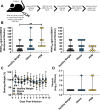Nutritional status impacts dengue virus infection in mice
- PMID: 32854687
- PMCID: PMC7453574
- DOI: 10.1186/s12915-020-00828-x
Nutritional status impacts dengue virus infection in mice
Abstract
Background: Dengue virus (DENV) is estimated to infect 390 million people annually. However, few host factors that alter disease severity are known. Malnutrition, defined as both over- and undernutrition, is a growing problem worldwide and has long been linked to dengue disease severity by epidemiological and anecdotal observations. Accordingly, we sought to establish a mouse model to assess the impact of nutritional status on DENV disease severity.
Results: Using transiently immunocompromised mice, we established a model of mild dengue disease with measurable viremia. We then applied it to study the effects of healthy weight, obese, and low-protein diets representing normal, over-, and undernutrition, respectively. Upon infection with DENV serotype 2, obese mice experienced more severe morbidity in the form of weight loss and thrombocytopenia compared to healthy weight groups. Additionally, obesity altered cytokine expression following DENV infection. Although low protein-fed mice did not lose significant weight after DENV2 infection, they also experienced a reduction in platelets as well as increased spleen pathology and viral titers.
Conclusions: Our results indicate that obese or undernourished mice incur greater disease severity after DENV infection. These studies establish a role for nutritional status in DENV disease severity.
Keywords: Arbovirus; Dengue virus; Disease severity; Malnutrition; Nutrition; Nutritional immunology.
Conflict of interest statement
The authors declare that they have no competing interests.
Figures






References
-
- Sangkawibha N, Rojanasuphot S, Ahandrik S, Viriyapongse S, Jatanasen S, Salitul V, et al. Risk factors in dengue shock syndrome: a prospective epidemiologic study in Rayong, Thailand. I. The 1980 outbreak. Am J Epidemiol. 1984;120:653–669. - PubMed
-
- Burke DS, Nisalak A, Johnson DE, Scott RM. A prospective study of dengue infections in Bangkok. Am J Trop Med Hyg. 1988;38:172–180. - PubMed
-
- Obesity and overweight. https://www.who.int/news-room/fact-sheets/detail/obesity-and-overweight. Accessed 25 Mar 2019.
Publication types
MeSH terms
Grants and funding
LinkOut - more resources
Full Text Sources
Medical

